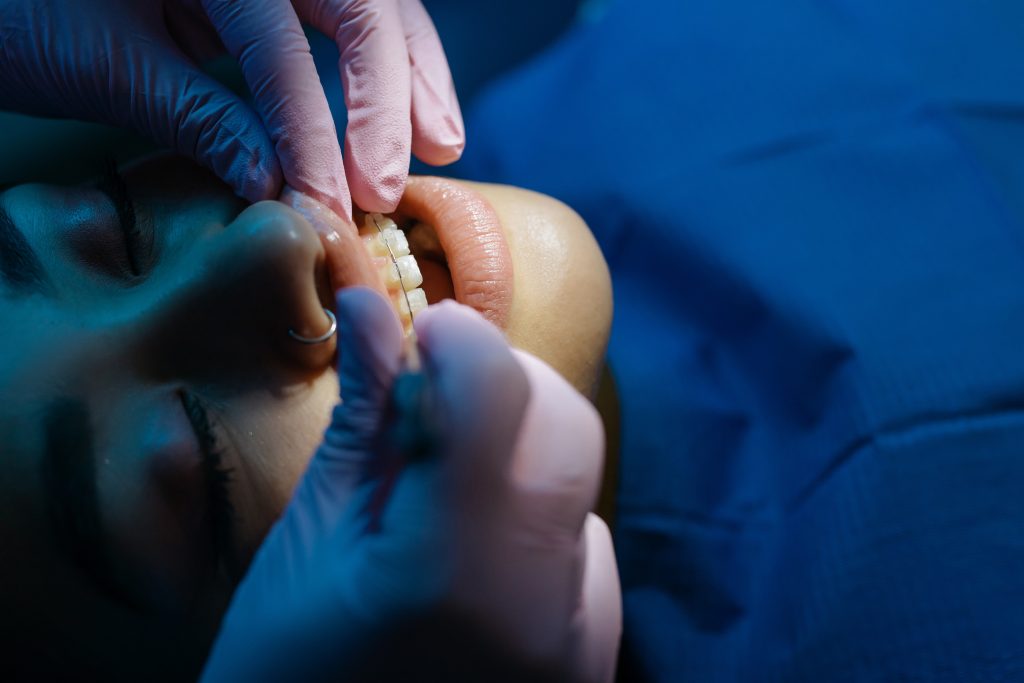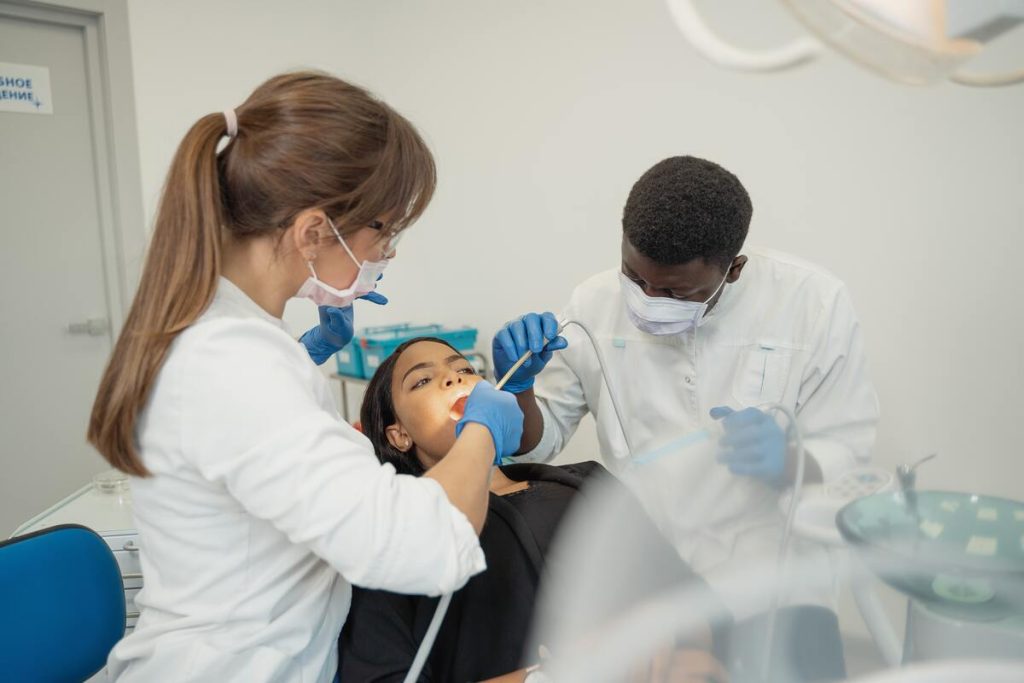Introduction:
IV Sedation Dentistry- IV sedation dentistry, also known as intravenous sedation dentistry, is a specialised technique that allows patients to undergo dental procedures while in a deeply relaxed and sedated state. This method involves the administration of sedative medications directly into the patient’s bloodstream through an intravenous line, ensuring a quick and controlled onset of sedation. IV sedation dentistry is commonly used for individuals with dental anxiety, fear, or phobia, as well as those undergoing complex or lengthy dental treatments.
Unlike other forms of sedation, such as oral sedation or nitrous oxide, IV sedation provides a higher level of sedation, allowing patients to be in a sleep-like state throughout the procedure. This deep relaxation not only reduces anxiety and discomfort but also enables the dentist to work efficiently and effectively. Furthermore, IV sedation dentistry ensures patient safety by allowing the dental team to closely monitor vital signs, oxygen levels, and overall well-being during the entire procedure.
IV sedation dentistry has revolutionised dental care, making it more accessible and comfortable for patients who would otherwise avoid or postpone necessary treatments due to anxiety or fear. By inducing a state of deep relaxation, patients can receive the dental care they need while being blissfully unaware of the sounds, smells, and sensations associated with dental procedures.
What is IV sedation dentistry?
During IV sedation, the patient remains conscious but is in a sleep-like state, experiencing a profound sense of relaxation and reduced awareness of the surrounding environment. This level of sedation is deeper than other forms of sedation used in dentistry, such as oral sedation or nitrous oxide.
IV sedation dentistry is commonly employed for individuals with dental anxiety, fear, or phobia, as well as those requiring extensive or complex dental treatments. It helps alleviate patient discomfort, anxiety, and fear associated with dental procedures, making the experience more comfortable and tolerable.
Moreover, IV sedation allows the dental team to work more efficiently and effectively since the patient is in a relaxed state. This is particularly beneficial for procedures that require a significant amount of time or involve multiple dental treatments.
Throughout the IV sedation process, the patient’s vital signs and overall well-being are closely monitored by trained dental professionals to ensure their safety and comfort. This monitoring includes oxygen levels, blood pressure, heart rate, and respiratory function.

How is IV sedation administered?
Intravenous (IV) sedation is a method of administering sedative medications directly into the bloodstream to induce a state of relaxation, drowsiness, or even sleep during medical or dental procedures. It is typically performed by a trained healthcare professional, such as an anesthesiologist or a dentist with specialised training in sedation.
Here’s a general overview of how IV sedation is administered:
Preparation: Before the procedure, the healthcare professional will assess your medical history, current health condition, and any medications you are taking to determine if IV sedation is suitable for you. They will also explain the procedure and address any concerns or questions you may have.
Monitoring: During IV sedation, your vital signs such as heart rate, blood pressure, and oxygen levels are continuously monitored to ensure your safety throughout the procedure. Electrocardiography (ECG) electrodes, a blood pressure cuff, and a pulse oximeter may be attached to you for monitoring purposes.
IV line placement: An IV line is established by inserting a small needle into a vein, usually in the arm or hand. The needle is then removed, leaving a small, flexible tube (cannula) in place. The cannula allows for the administration of medications directly into your bloodstream.
Medication administration: The sedative medications are delivered through the IV line. The specific medications used can vary depending on the procedure, your medical condition, and the healthcare professional’s preference. Commonly used medications include benzodiazepines, such as midazolam or diazepam, and sometimes an analgesic, such as fentanyl, may also be given for pain relief.
Adjusting the dosage: The healthcare professional will carefully monitor your level of sedation throughout the procedure and may adjust the dosage of medications as needed to ensure you remain comfortable and relaxed.
What are the benefits of IV sedation?
IV sedation offers several benefits for patients undergoing medical or dental procedures. Firstly, it provides increased comfort and relaxation, helping to alleviate anxiety, fear, and discomfort. This allows patients to undergo treatments without experiencing significant pain or distress, leading to a more positive overall experience.
Secondly, IV sedation can cause temporary amnesia or partial memory loss. This is beneficial for individuals who may have traumatic memories or phobias related to medical or dental procedures. The lack of memory of the procedure can contribute to a reduction in anxiety and a more positive outlook towards future treatments.
Moreover, IV sedation enhances safety and control during procedures. Trained healthcare professionals administer and monitor the sedation process, ensuring the patient’s vital signs are continuously checked and maintained within safe parameters.
Furthermore, IV sedation can be tailored to meet the specific needs of each patient. The dosage can be adjusted to achieve the desired level of sedation, ranging from mild relaxation to deep sleep, depending on the procedure and the patient’s comfort level.

Is IV sedation safe?
The safety of IV sedation depends on various factors, including the patient’s overall health, medical history, and the expertise of the healthcare provider.
One of the key safety measures during IV sedation is continuous monitoring of vital signs, such as heart rate, blood pressure, and oxygen levels. This helps ensure that the patient’s physiological parameters remain stable throughout the procedure. Additionally, the presence of trained healthcare professionals who are experienced in sedation and anaesthesia further enhances safety by closely monitoring the patient’s response and adjusting the medication dosage as needed.
Although complications are rare, some potential risks associated with IV sedation may include allergic reactions to medications, respiratory depression, or rare instances of medication overdose. However, these risks are minimised through proper patient assessment, individualised dosing, and vigilant monitoring during the sedation process.
To enhance safety, it is crucial for patients to disclose their complete medical history, including any allergies or medications they are currently taking, to their healthcare provider. This information allows the provider to make informed decisions and tailor the sedation approach accordingly.
Who is a suitable candidate for IV sedation dentistry?
Patients who experience dental anxiety or fear are prime candidates for IV sedation. Dental phobia or high levels of anxiety can make it challenging for individuals to undergo necessary dental treatments. IV sedation helps alleviate fear and anxiety, allowing patients to receive the care they need without distress.
Individuals who have difficulty sitting still for prolonged periods may also benefit from IV sedation. This includes young children or patients with physical or cognitive disabilities. IV sedation helps keep these patients calm and cooperative, facilitating the completion of dental procedures more effectively.
Those with a sensitive gag reflex can find relief through IV sedation dentistry. A strong gag reflex can interfere with dental treatments and make it uncomfortable for patients. IV sedation helps suppress the gag reflex, enabling dentists to perform procedures more smoothly and minimising discomfort.
Furthermore, individuals who require complex or lengthy dental procedures may be suitable candidates for IV sedation. By inducing a state of deep relaxation, IV sedation allows dentists to work more efficiently and complete procedures in a single session. This reduces the need for multiple appointments and provides convenience for patients.

What types of dental procedures can be performed under IV sedation?
IV sedation can be used for a wide range of dental procedures, including both simple and complex treatments. It is particularly beneficial for patients who experience dental anxiety, have difficulty sitting still, or require extensive dental work. Some of the dental procedures that can be performed under IV sedation include:
Tooth extractions: IV sedation can be used for the removal of impacted wisdom teeth or other difficult extractions, ensuring the patient’s comfort throughout the procedure.
Dental implant placement: For patients undergoing dental implant surgery, IV sedation can help create a relaxed and stress-free environment, allowing the dentist to perform the procedure with precision.
Root canal treatment: IV sedation can be used for patients undergoing root canal therapy, which involves removing infected pulp from the tooth. It helps keep the patient calm and comfortable during the procedure.
Complex restorative procedures: IV sedation is often used for extensive restorative treatments, such as full-mouth rehabilitation or multiple tooth reconstructions. It allows for longer treatment sessions, reducing the need for multiple appointments and providing a more efficient and comfortable experience.
Periodontal surgeries: Patients undergoing periodontal procedures, such as gum grafting or crown lengthening, can benefit from IV sedation. It helps keep them relaxed and minimises any potential discomfort during these surgical treatments.
Paediatric dentistry: IV sedation can be used for children who require dental treatments but may have difficulty cooperating or experiencing dental anxiety. It helps create a calm and cooperative environment for paediatric procedures.
What are the potential side effects of IV sedation?
Nausea and vomiting are possible side effects, particularly for individuals who are prone to motion sickness or have a sensitivity to anaesthesia. However, anti-nausea medications can often be administered before or during the procedure to mitigate these effects.
In rare cases, patients may experience headaches or muscle soreness following IV sedation. These symptoms are usually short-lived and can be managed with over-the-counter pain medications if necessary.
There is also a risk of allergic reactions to the medications used in IV sedation. It is essential to inform the healthcare provider about any known allergies or adverse drug reactions beforehand to minimise this risk.
In very rare instances, complications such as respiratory depression, a drop in blood pressure, or cardiac events may occur. However, the presence of trained healthcare professionals who closely monitor vital signs during the procedure significantly reduces the likelihood of such complications and allows for immediate intervention if needed.

Are there any alternative sedation options to IV sedation dentistry?
Oral sedation involves taking prescribed medications in pill or liquid form before the dental procedure, inducing a relaxed and drowsy state. Nitrous oxide sedation, also known as “laughing gas,” is inhaled through a mask, providing mild sedation and relaxation. Local anaesthesia blocks pain signals in the specific area being treated, typically used in combination with other sedation techniques to ensure a pain-free dental experience. General anaesthesia, reserved for more complex cases, induces a controlled state of unconsciousness using intravenous medications.
It’s important to note that each sedation method has its own benefits and considerations. Dentists will evaluate the patient’s overall health, level of anxiety, and the nature of the dental procedure to determine the most suitable sedation approach, ensuring a comfortable and stress-free experience.
Oral sedation involves taking prescribed medications, typically in pill form, prior to the dental procedure. These medications induce relaxation and a drowsy state, reducing anxiety and discomfort during the treatment.
Nitrous oxide sedation, also known as “laughing gas,” is a commonly used sedative in dentistry. It is inhaled through a mask and provides a mild level of sedation and relaxation. Nitrous oxide helps patients feel more at ease while remaining conscious and responsive throughout the procedure.
It’s important to consult with a qualified dentist or oral surgeon to discuss the available alternatives and determine the best sedation option based on individual needs and preferences.
Conclusion:
IV sedation dentistry is a valuable technique that provides deep relaxation and comfort for patients during dental procedures. By administering sedative medications intravenously, dentists can induce a state of profound relaxation, alleviating anxiety, fear, and discomfort associated with dental treatments. The benefits of IV sedation include improved patient cooperation, reduced gag reflex, and the ability to perform complex or lengthy procedures more efficiently.
IV sedation dentistry offers a safe and controlled sedation experience, with dentists closely monitoring vital signs and adjusting the sedation level as needed. It is a suitable option for individuals with dental phobia, anxiety, or special needs, allowing them to receive necessary dental care without undue stress.
Furthermore, IV sedation dentistry enables dentists to deliver comprehensive treatments, including oral surgeries, extractions, and implant placements, while ensuring patient comfort and relaxation throughout the procedure.







